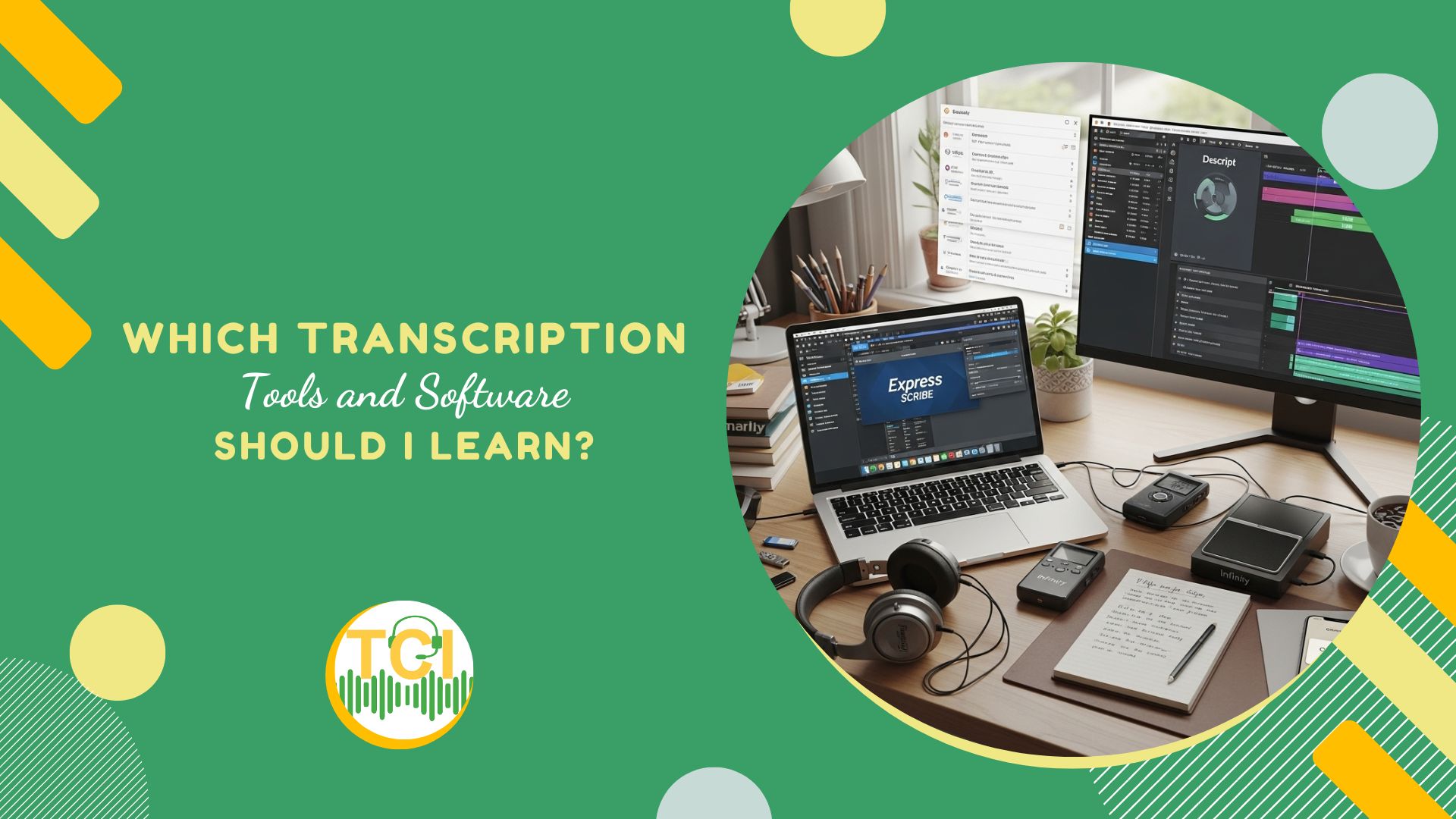If you're considering a career in transcription, you’re likely aware that it’s a skill in high demand across industries like legal, media, and corporate fields. With so many transcription tools out there, it’s easy to feel overwhelmed when deciding which ones to focus on.
The right transcription software can save you time, boost your accuracy, and streamline your workflow. Whether you’re just starting out or looking to improve your existing skills, knowing which tools are essential for your career can make all the difference.
Why Do Transcription Tools Matter?
Transcription tools are more than just software, they're your gateway to efficiency and accuracy in transforming audio or video into text. These tools streamline the transcription process, helping professionals save time, improve productivity, and maintain accuracy. Whether you're looking to transcribe interviews, meetings, or court proceedings, knowing which tools will give you an edge is essential. The right transcription software can make all the difference in your career, whether you’re just starting out or looking to level up your skills.
Types of Transcription Tools You Should Master
Transcription tools come in many forms, some cater to specific needs, while others are versatile and used across industries.
1. Transcription Software: The Foundation of Your Work
Transcription software is the backbone of your job as a transcriptionist. These tools allow you to control audio playback, add timestamps, manage shortcuts, and even use foot pedals to streamline your workflow. Whether you're a beginner or an experienced pro, these tools are crucial for accuracy and speed:
- Express Scribe (Windows/Mac): A widely-used tool among professional transcriptionists, Express Scribe supports hotkeys, foot pedal integration, and variable speed playback. It’s perfect for handling multi-format audio files and is a must-have for serious transcription work.
- oTranscribe (Web-based): A great option for beginners or those who need a free tool. oTranscribe is web-based, user-friendly, and lets you control both the audio and text in one window. It’s ideal for quick transcription tasks or practice work.
- The FTW Transcriber: Lightweight and easy to use, FTW Transcriber offers automatic timestamps, hotkeys, and foot pedal support. It’s perfect for transcriptionists who need to transcribe quickly and efficiently.
2. Speech Recognition Software: Jumpstart Your Transcriptions
While speech recognition software should never replace manual transcription entirely, it’s a helpful tool to speed up the transcription process and generate rough drafts. Here are some AI tools to consider for transcription work:
- Otter.ai: This AI-powered tool is highly recommended for transcriptionists who handle interviews, meetings, or lectures. Otter.ai provides real-time transcription with speaker identification, making it especially useful for collaborative environments.
- Temi: For an affordable and fast transcription tool, Temi is a solid choice. It’s an automated transcription service that works best with clear audio. While not 100% accurate, it’s great for quickly generating rough drafts.
- Descript: Descript combines transcription with audio editing, making it ideal for those working with podcasts or video content. It allows you to transcribe audio, edit both the text and audio, and even overdub voices using AI, making it perfect for content creators and media professionals.
3. Text Expanders and Editing Tools: Boost Your Efficiency
As a transcriptionist, you’ll often type the same phrases, speaker labels, or terms repeatedly. Text expanders and editing tools help automate these repetitive tasks and improve the overall quality of your transcriptions:
- TextExpander or PhraseExpress: These tools allow you to create shortcuts for common phrases and speaker labels, saving you time and reducing repetitive typing.
- Grammarly or Hemingway Editor: For accuracy, grammar checks, and readability improvements, Grammarly helps with error correction, while Hemingway Editor ensures your transcriptions are clear and concise.
- Microsoft Word / Google Docs: Mastering advanced features like formatting shortcuts, tracking changes, and voice typing in these word processors will make your transcription work more efficient and organized.
4. Foot Pedal Integration: Keep Your Hands on the Keyboard
Foot pedals are essential for transcriptionists. They allow you to pause, rewind, or fast-forward audio without taking your hands off the keyboard, making the transcription process faster and more efficient:
- Infinity USB Foot Pedals: Popular among transcriptionists, Infinity foot pedals integrate seamlessly with tools like Express Scribe and InqScribe. They are durable and help increase transcription speed.
- VEC Infinity IN-USB-2: Known for its reliability, this foot pedal works with many transcription software options, allowing transcriptionists to work quickly without interruptions.
Also Read: How to Choose the Best Transcription Foot Pedal
5. Project and Time Management Tools: Stay Organized
Transcription work often involves handling multiple projects with tight deadlines. Staying organized is essential, and these tools will help you track and manage your time:
- Trello / Asana / Notion: These project management tools are perfect for organizing transcription tasks. You can track deadlines, prioritize tasks, and collaborate with other transcriptionists or clients.
- Toggl / Clockify: Time-tracking tools like Toggl and Clockify are especially useful for freelancers. These tools let you track how much time you spend on each transcription project, making billing clients based on hours or audio minutes easy.
6. File Conversion Tools: Handle Any Format
Not all audio and video files are transcription-ready. Sometimes, files need to be converted into compatible formats. These file conversion tools ensure you can handle any format:
- Audacity: This free, open-source audio editor is great for cleaning up audio by removing background noise, adjusting volumes, or trimming unnecessary parts. It's perfect for preparing files for transcription.
- Any Video Converter / HandBrake: Use these tools to convert video files into audio or other formats that are compatible with transcription software. Whether you’re transcribing an interview or podcast, these tools help ensure your file is in the right format.
7. AI-Enhanced Transcription Platforms: Modern Transcription with AI
AI transcription platforms are transforming the transcription industry by combining automated transcriptions with manual editing features. These platforms offer a faster, more accurate workflow:
- DictaAI: This AI-powered platform is specifically designed for transcription work. It offers fast and accurate transcriptions, making it ideal for legal and professional transcriptionists. It also features multi-speaker transcription and an intuitive editing dashboard.
- Rev Transcription Software: Rev is one of the most widely used transcription platforms, offering both manual and automated transcription services. It supports timestamping, speaker labels, and easy audio navigation, making it a favorite among transcriptionists.
- Sonix.ai: This multilingual transcription tool supports over 40 languages, making it perfect for transcriptionists working with global clients. It combines AI transcription with editing tools, speeding up the process and increasing accuracy.
- Trint: Trint’s real-time transcription, search features, and collaborative editing make it ideal for journalists and content creators. It’s great for team projects and allows easy syncing of audio and text.
8. Secure File Transfer and Storage: Protect Your Data
When handling sensitive client information, security is crucial. These tools ensure your files are shared and stored safely:
- Dropbox / Google Drive: These cloud storage platforms are excellent for backing up and securely sharing your transcription files. They also allow easy collaboration with clients and colleagues.
- WeTransfer / Hightail: These platforms make it easy to send large audio or video files securely, ensuring that your files are transferred without risk.
Final Thoughts
Whether you're just starting or looking to refine your transcription skills, Transcription Certification Institute (TCI) is here to guide you. Our programs equip you with the essential tools and techniques needed to succeed and stand out in the industry.
Enroll Now


